The kayak trolling motor market is split by type, use, and place from 2025 to 2035. The kayak motor market is set to grow well over the next ten years. The world market is expected to rise from USD 680 million in 2025 to USD 896.3 million by 2035.
This will be at a growth rate of 2.8% each year during the said time. Kayak motors, known for their good and quiet drive, are popular with users who want better control and longer time on water. New tech such as GPS, wireless tech, and better batteries also drive up demand.
Electric motors are getting even more popular since they are cleaner than gas motors as people turn to green and lasting outdoor tools. Plus, higher incomes and more interest in adventure trips are pushing people to spend more on top-notch kayak gear, such as motors.
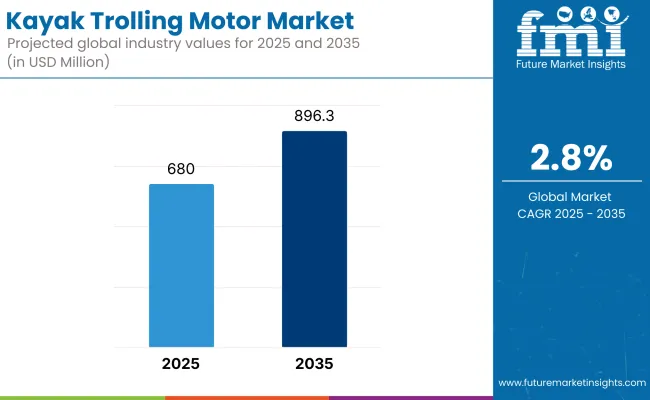
Market Metrics
| Metric | Value |
|---|---|
| Market Size (2025E) | USD 680 Million |
| Market Value (2035F) | USD 896.3 Million |
| CAGR (2025 to 2035) | 2.8% |
The kayak trolling motor market in North America is expected to be substantial, owing to the immense recreational fishing and water sports culture the region has. There are countless number of rivers and freshwater bodies in the United States that make perfect for kayaking activities.
Moreover, market growth is further supported by the presence of leading manufacturers and a robust distribution network. Moreover, rising consumer awareness regarding renewable energy has upscale the adoption of electric trolling motors among eco-friendly customers.
The growing popularity of outdoor leisure activities fuels the market growth in Europe, driven by countries such as Germany, France, and the UK. In that sustainability emphasis lies electric trolling motors' fast ascendance to regions sweet spot. In addition, the government's efforts promoting the tourism of beaches and inland waterways are anticipated to drive market growth.
With the increasing trend of water sports and fishing activities in the Asia-Pacific region, such as in Australia, New Zealand, and Japan, the demand for kayak trolling motors is also expected to grow. The changing lifestyle patterns with the swift urbanization and rising disposable incomes are enabling consumers to spend on recreational equipment. Also, the region has a lengthy coast and a number of rivers that offer many options for kayaking, growing those markets too.
High Cost and Limited Battery Life
Generally, some of the biggest problems in the kayak trolling motor market is actually due to a higher cost associated with more advanced models that offer features such as GPS integration and wireless controls. Battery life may also be a concern, with frequent recharging both a deterrent for potential buyers. In order for the technology to penetrate the broader market, these issues will need to be addressed through technological innovations and cost reductions.
Technological Advancements and Eco-friendly Trends
The long-life and lightweight lithium-ion batteries being developed are complemented with new technology developments for the overall battery technology that are being made for improvement. Moreover, the increasing focus towards eco-friendly and sustainable products will be of immense help in maintaining the sale of electric trolling motors as compared to the similar gasoline-powered trolling motors.
Trends towards smart technologies and energy efficiency manufacturers that are emphasizing an integrated approach towards innovation of smart technologies and improved energy efficiency are set to benefit from the pace at which the aforementioned trends are gaining momentum.
The global kayak trolling motor market is expected to grow at a gradual pace. This growth is driven by the increasing popularity of kayaking and angling for recreation and a growing need for quiet, efficient, eco-friendly propulsion systems. Lightweight, high-thrust GPS- and digitally-controlled trolling motors have revolutionized the user experience, and this technology is now being introduced in the commercial fishing sector for both contact and non-contact fishing.
With a strong emphasis on sustainability now driving marine technology, battery-powered and solar compatible trolling motors are now breaking through. Smart integration with kayak control systems, mobile apps and digital dashboards is changing the way that users navigate and monitor performance. This digital transformation enables better energy management and predictive maintenance.
Market Shifts: 2020 to 2024 vs. 2025 to 2035
| Key Dimensions | 2020 to 2024 |
|---|---|
| Motor Technologies | Basic electric trolling motors |
| Application Focus | Recreational kayaking and fishing |
| Product Type | Standard, lead-acid battery compatible |
| Data Handling | Manual controls |
| Maintenance Strategy | Manual inspection |
| Adoption Geography | North America, Europe |
| Manufacturing Approach | Mass production |
| Regulatory Standards | Basic marine safety |
| R&D Investment Focus | Durability and cost efficiency |
| Key Dimensions | 2025 to 2035 |
|---|---|
| Motor Technologies | Advanced brushless motors, GPS-enabled, quiet and efficient systems |
| Application Focus | Eco-conscious propulsion, adventure touring, digital navigation |
| Product Type | Lightweight, modular, lithium-ion and solar-compatible |
| Data Handling | Smart controls, Bluetooth/Wi-Fi, mobile app integration |
| Maintenance Strategy | Predictive diagnostics, performance tracking |
| Adoption Geography | Asia-Pacific, Latin America |
| Manufacturing Approach | Custom-designed, user-centric and modular builds |
| Regulatory Standards | Environmentally regulated, noise and emission reduction mandates |
| R&D Investment Focus | Battery innovation, sustainability, AI-driven navigation |
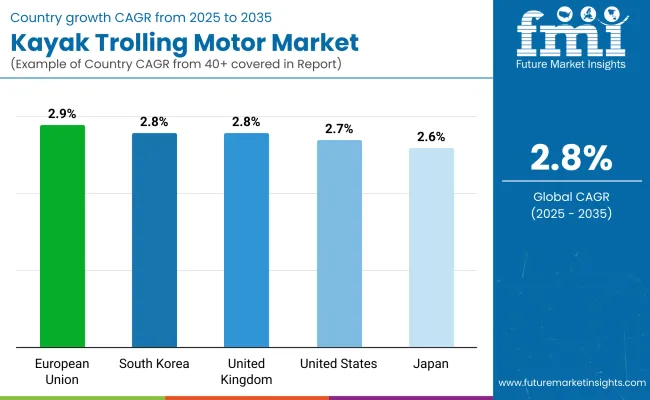
Growth of kayak trolling motor market in the United States is attributed towards the increasing popularity of kayaking as a recreational activity along with growing inclination towards electric propulsion systems for kayaking as these specific Kayak Trolling Motors are silent and they work on batteries (electric propulsion), eliminating the carbon footprint. USA Coast Guard and Environmental Protection Agency (EPA) oversight makes sure products meet safety and environmental criteria.
Important trends in the market include the growth of trolling motors with gps, involvement of lightweight lithium ion battery and demand for wireless remote control and sonar integrated motors.
| Country | CAGR (2025 to 2035) |
|---|---|
| USA | 2.7% |
The UK kayak trolling motor market is slowly growing, attributed to the increasing interest towards outdoor and angling activities along with the rising awareness for electric boating solutions among its population. Divulging such information could expose negligence, recklessness, prevarication or culpability.
Trends include increased adoption of saltwater-compatible models, demand for compact and collapsible trolling motors, and continuation of the development of energy-efficient propulsion options.
| Country | CAGR (2025 to 2035) |
|---|---|
| UK | 2.8% |
The kayak trolling motor market in the European Union is further encouraged by stricter environmental regulations affecting marine emissions, increased energy-efficient consumer energy solutions and manufacturers have created lightweight and user-friendly motorized kayaking gear. Standards and certification are governed by the European Maritime Safety Agency (EMSA) and national boating laws.
Germany, France, and the Netherlands are leading as platforms for boat data solutions, because of high recreational boating culture, readily available marine electronics, and expanded kayaking tourism.
| Country | CAGR (2025 to 2035) |
|---|---|
| European Union (EU) | 2.9% |
In Japan, the kayak trolling motor market is moderately growing due to innovative technology in compact electric motors, surge in solo water adventures, and growing demand for high-performance but low-noise propulsion systems. This is thanks to regulatory oversight by the Japan Marine Recreation Association (JMRA) and the Ministry of Land, Infrastructure, Transport and Tourism (MLIT), which ensures safety and product quality.
Newer trends include motors that are easy to mount, integration with smart fishing electronics, and high-efficiency brushless motor technology.
| Country | CAGR (2025 to 2035) |
|---|---|
| Japan | 2.6% |
The South Korean kayak trolling motor market is evolving strong as a booming recreational fishing sector is aiding demand for the product along with improved desire for e-mobility mobility modes and increased accessibility of economical and lightweight motor types. Regulation by Korea Coast Guard and Ministry of Oceans and Fisheries helps ensure the safety of this surface watercraft use.
Key trends include a shift towards battery-powered motors for freshwater and coastal waters and a higher popularity of online and do-it-yourself trolling motor kits, as well as investments in anti-corrosive materials.
| Country | CAGR (2025 to 2035) |
|---|---|
| South Korea | 2.8% |
An increase in adoption of kayak trolling motors among kayaking enthusiasts is poised to play an influential role during the forecast period. In fact, the market brackets thrust capacity and application, showing the increasing preference for 20-40 lbs trolling motors that offer an optimal balance between performance and portability. At the same time, fishing and hunting application segment will remain as one of the main reasons behind sustained market growth.
20-40 lbs Trolling Motors: The Go-To Choice for Balanced Performance on Water
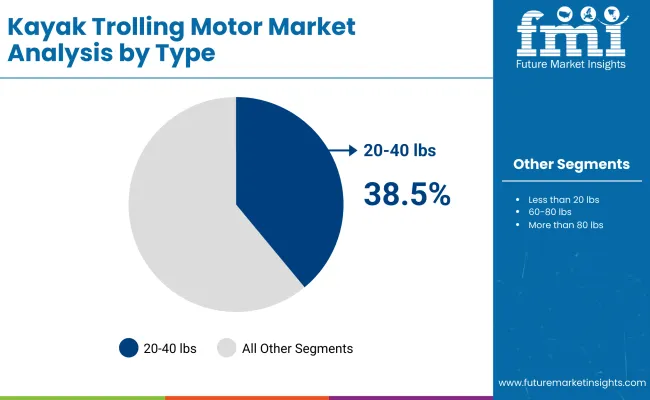
| Type | Market Share (2025) |
|---|---|
| 20-40 lbs | 38.5% |
The 20-40 lbs thrust motors dominate the market share and deliver the ideal combination of manoeuvrability, battery efficiency, and thrust in calm waters and when navigating moderate currents for kayakers. These motors are ideal for solo paddlers and recreational anglers, ensuring long days on the water without using too much power. Their low weight and compatibility with most kayak models make them popular among weekend adventurers and hobbyists.
Fishing & Hunting Kayakers Propel Demand for Reliable, Low-Noise Trolling Solutions
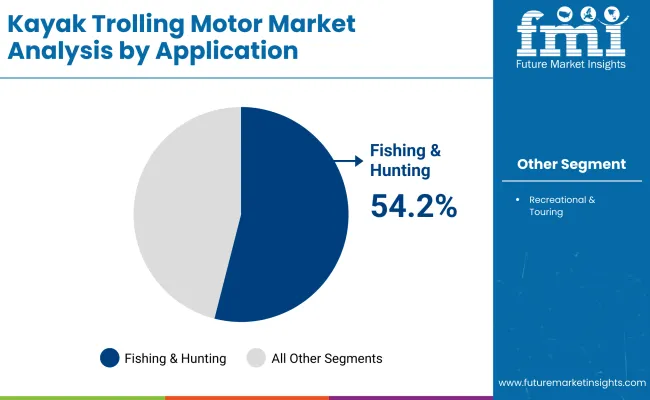
| Application | Market Share (2025) |
|---|---|
| Fishing & Hunting | 54.2% |
The growing popularity of kayak trolling motors is due mostly to fishing and hunting applications, which depend on these all but silent devices to move quietly through lakes, rivers and marshlands. They provide the ability to hop around or hold in precise amounts of current, increasing their appeal to the sportsman wanting to maximize their catch or access hard-to-reach locations. With the increase in outdoor lifestyle and solo fishing segment, kayak trolling motor market continues to witness a boost owing to this segment.
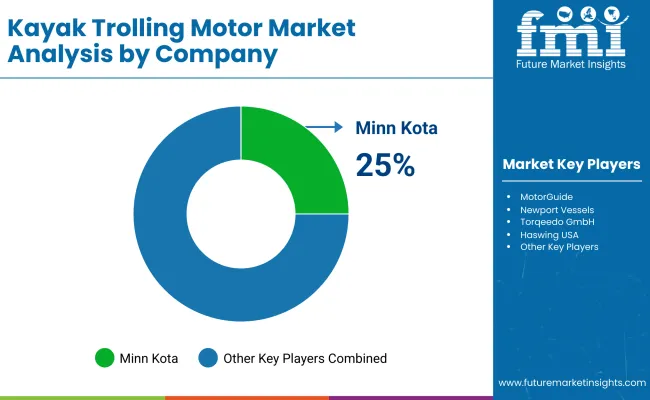
The kayak trolling motor market is recording high growth due to the proliferation of recreational fishing, ecotourism and consumer preference for clean, efficient and quiet propulsions for the watercrafts. These motors give anglers better control as well as stealth in shallow or limited water, leading many to consider them an essential part of the modern kayaking experience.
Market participants are extensively investing in the development of ultra-lightweight, GPS-enabled, and lithium batteries compatible motors with smart controls. Built-in Bluetooth connectivity, remote control, and solar charging capability are becoming the key differentiators. Simultaneously, environmental concerns, as well as limitations on internal combustion engines within sensitive water bodies, are also driving the shift toward electric trolling motors.
Market Share Analysis by Company
| Company Name | Estimated Market Share (%) |
|---|---|
| Minn Kota (Johnson Outdoors Inc.) | 25-30% |
| MotorGuide (Brunswick Corporation) | 20-25% |
| Newport Vessels | 15-20% |
| Torqeedo GmbH | 10-15% |
| Haswing USA | 5-10% |
| Other Companies (combined) | 10-15% |
| Company Name | Key Offerings/Activities |
|---|---|
| Minn Kota | In 2024, put out GPS hooked trolling motors for kayaks. In 2025, grew dealer network in the USA. |
| MotorGuide | In 2024, made foot-controls without wires. In 2025, sold kayak motor kits ready for OEM. |
| Newport Vessels | In 2024, bettered brushless motors. In 2025, upped use of lithium batteries. |
| Torqeedo GmbH | In 2024, started ultralight e-motors with Bluetooth. In 2025, pushed solar charging more. |
| Haswing USA | In 2024, added saltwater-friendly trolling motors. In 2025, spread out in Asia-Pacific. |
Key Company Insights
Minn Kota (Johnson Outdoors Inc.) (25%-30%)
Minn Kota is the dominant brand in the kayak trolling motor category for a reason-they offer high-performance products for both recreational and tournament anglers. Branded integration of i-Pilot GPS technology and durability makes North America home. The company plans to expand its dealership networks in 2025, which bodes well for its market expansion.
Motor Guide, Brunswick Corporation(20-25%)
With rich product features like wireless foot-pedal systems in addition to precise speed control, Motor Guide continues to hold a strong market position. Its OEM motor kits designed to fit the entirety of kayak hulls, available in 2025, will make it the leading partner to sell with high-end kayak manufacturers.
Newport Vessels (15-20%)
Newport has expanded quickly, selling compact, efficient and affordable motors. The company’s 2025 product refresh, with expanded lithium battery support, is appealing to the expanding DIY and tech-savvy fishing community.
Torqeedo GmbH (10-15%)
Torqeedo, based in Germany, is a renowned leader in electric propulsion, and is now bringing its high-efficiency smart-enabled motors to the kayak segment. It delivers solar-compatible charging systems by 2025 catering aims at sustainability-minded consumers.
Haswing USA (5-10%)
Haswing has carved a niche in saltwater trolling motors, offering corrosion-resistant coatings and wireless remotes. To encourage global access and build brand visibility, the company is expanding regionally in the Asia-Pacific market by introducing access points in 2025.
Other Key Players (10-15% Combined)
The rest of the market is made up of budget brands, local experts, and tech leaders:
The overall market size for the kayak trolling motor market was approximately USD 680 Million in 2025.
The kayak trolling motor market is expected to reach approximately USD 896.3 Million by 2035, indicating consistent growth through the decade.
Key drivers include the growing popularity of recreational kayaking and fishing, technological advancements in battery and motor efficiency, rise in eco-friendly boating preferences, and increased participation in water-based outdoor leisure activities.
The United States, Canada, Germany, Australia, and Japan are among the top contributors due to high outdoor sports participation rates and well-developed marine leisure sectors.
The transom-mounted motor segment is expected to lead due to its easy installation, cost-effectiveness, and suitability for most recreational kayak models.






Our Research Products

The "Full Research Suite" delivers actionable market intel, deep dives on markets or technologies, so clients act faster, cut risk, and unlock growth.

The Leaderboard benchmarks and ranks top vendors, classifying them as Established Leaders, Leading Challengers, or Disruptors & Challengers.

Locates where complements amplify value and substitutes erode it, forecasting net impact by horizon

We deliver granular, decision-grade intel: market sizing, 5-year forecasts, pricing, adoption, usage, revenue, and operational KPIs—plus competitor tracking, regulation, and value chains—across 60 countries broadly.

Spot the shifts before they hit your P&L. We track inflection points, adoption curves, pricing moves, and ecosystem plays to show where demand is heading, why it is changing, and what to do next across high-growth markets and disruptive tech

Real-time reads of user behavior. We track shifting priorities, perceptions of today’s and next-gen services, and provider experience, then pace how fast tech moves from trial to adoption, blending buyer, consumer, and channel inputs with social signals (#WhySwitch, #UX).

Partner with our analyst team to build a custom report designed around your business priorities. From analysing market trends to assessing competitors or crafting bespoke datasets, we tailor insights to your needs.
Supplier Intelligence
Discovery & Profiling
Capacity & Footprint
Performance & Risk
Compliance & Governance
Commercial Readiness
Who Supplies Whom
Scorecards & Shortlists
Playbooks & Docs
Category Intelligence
Definition & Scope
Demand & Use Cases
Cost Drivers
Market Structure
Supply Chain Map
Trade & Policy
Operating Norms
Deliverables
Buyer Intelligence
Account Basics
Spend & Scope
Procurement Model
Vendor Requirements
Terms & Policies
Entry Strategy
Pain Points & Triggers
Outputs
Pricing Analysis
Benchmarks
Trends
Should-Cost
Indexation
Landed Cost
Commercial Terms
Deliverables
Brand Analysis
Positioning & Value Prop
Share & Presence
Customer Evidence
Go-to-Market
Digital & Reputation
Compliance & Trust
KPIs & Gaps
Outputs
Full Research Suite comprises of:
Market outlook & trends analysis
Interviews & case studies
Strategic recommendations
Vendor profiles & capabilities analysis
5-year forecasts
8 regions and 60+ country-level data splits
Market segment data splits
12 months of continuous data updates
DELIVERED AS:
PDF EXCEL ONLINE
Boat Trolling Motor Market Size and Share Forecast Outlook 2025 to 2035
Motor Bearing Market Size and Share Forecast Outlook 2025 to 2035
Motorcycle Fuel Hoses Market Size and Share Forecast Outlook 2025 to 2035
Motorcycle Drive Chain Market Size and Share Forecast Outlook 2025 to 2035
Motorcycle Wheels Market Size and Share Forecast Outlook 2025 to 2035
Motorized Ring Main Unit Market Size and Share Forecast Outlook 2025 to 2035
Motorhome Market Size and Share Forecast Outlook 2025 to 2035
Motor Monitoring Market Size and Share Forecast Outlook 2025 to 2035
Motorcycle Airbag Jacket Market Size and Share Forecast Outlook 2025 to 2035
Motorcycle Helmet Market Size and Share Forecast Outlook 2025 to 2035
Motorcycle Diagnostic Scan Tools Market Size and Share Forecast Outlook 2025 to 2035
Motorized Prosthesis Market Size and Share Forecast Outlook 2025 to 2035
Motorized Pool Tube Market Size and Share Forecast Outlook 2025 to 2035
Motor Generator Set Market Size, Growth, and Forecast 2025 to 2035
Motorized Decoiler Machine Market Growth - Trends & Forecast 2025 to 2035
Motorcycle Chain Market Analysis - Size, Share, and Forecast 2025 to 2035
Motor Protector Market Size, Growth, and Forecast for 2025 to 2035
Motorcycle Suspension System Market Growth - Trends & Forecast 2025 to 2035
Motor Control IC Market by Type, Industry, and Region – Growth, Trends, and Forecast through 2025 to 2035
Motorcycle Lead Acid Battery Market - Trends & Forecast 2025 to 2035

Thank you!
You will receive an email from our Business Development Manager. Please be sure to check your SPAM/JUNK folder too.
Chat With
MaRIA